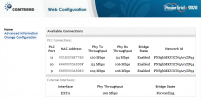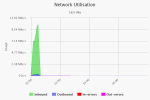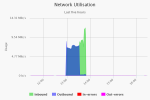...
I downloaded the sysmon package and decided to copy the STV HDTV file across the boxes this morning, my idea was to extrapolate bandwidth from file size and duration. I can see graphs; can I see numbers?
View attachment 5002
As a rough guess your file took 40 minutes to transfer, its size is probably close to 3500MB.
These are my findings when I tested the connection for my two HDR-FOX-T2, called HDR1 and HDR2.
The transfer speeds were read from the WebIF/Sysmon - Network Usage graphs.
Each have Generic rt3070 usb WiFi adapter (advertised as 150Mbps).
WiFi connected speed 54 Mbps (as shown on HDR1/2 menus).
Copying 500MB (476.84MiB)) file from HDR1 to HDR2 both using WiFi, via HDR1 Media - Video/Storage/USB to copy to HDR2.
Max 13.25Mibps approx 5.5 minutes.
Copying 500MB file from HDR1 to laptop/mobile using WiFi.
Max 21-26Mibps approx 2.25-3.25 minutes. Transfers to/from HDR2 were similar, but usually 5% slower.
Copying 500MB file from HDR1 to HDR2 using ethernet cable.
Max 62Mibps approx 1 minute or max 52Mibps approx 1.5 minute reverse direction.
I have nfs, smb and ftp installed on both HDR, they see each other using nfs (network shares automount).
I use FileZilla to transfer files to/from laptop and HDRs as it shows elapsed time in seconds.
I created a dummy file (500MB with ext mkv) to transfer by
dd bs=1MB if=/dev/urandom of=z-dummyfile1.mkv count=500 status=progress
edit1: I've tested transfer from HDR1 to laptop using smb, ftp and nfs. They seem to show similar speeds. smb and ftp are generally supported in android apps (and easy to setup/access via laptop), while nfs between the HDRs works best.






